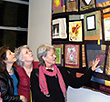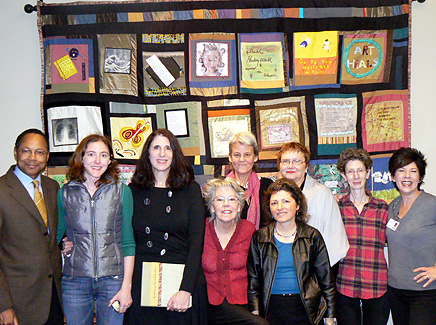
One by one, the patients who created Art for Recovery's latest quilt scanned the panels looking for the quilt square they had made.
It was both an emotional and stirring moment, as it was the first time many of them had seen the quilt in its finished form.
Eyes gazed from square to square, an inspired quilt sewn together with subtle earth-tone borders intermixed with brightly colored strips of material. Each was a 12" by 12" fabric square made from deep feelings of loss, healing and illness.
The occasion on Nov. 15 was a reception to bring together the quilt makers - patients and survivors of cancer - with Executive Vice Chancellor and Provost A. Eugene Washington, on whose wall, just above his desk, the quilt now graces.
"When I first saw the quilt, I was speechless, it is immensely touching," said Washington. "It conveys a strong sense of caring and is a poignant reminder of why we're here. At UCSF, we all work to ultimately promote health and prevent disease, and the quilt reminds us that our efforts are all about people - the individuals and their stories."
The 85" x 100" horizontal quilt was created by adults coping with life-threatening illnesses who participate in the UCSF Comprehensive Cancer Center's Art for Recovery program. Art for Recovery has provided workshops all over the Bay Area inviting women with breast cancer to have a voice.
Currently, more than 60 breast cancer quilts have been made; with each square honoring someone coping with breast cancer or in honor of a loved one. The Breast Cancer Quilts Project and other patient artwork are exhibited throughout the Cancer Center, in hospitals, civic and corporate offices and at selected events throughout the country.
 |
Executive Vice Chancellor Gene Washington, left, and Cindy Perlis, far right, stand before a quilt with some of the women who created the squares. |
"Art for Recovery gives patients coping with life-threatening illness the opportunity to express their feelings through the expressive arts," said Cindy Perlis, a clinical artist and director of the program. "The patients, many with no previous artistic or writing experience, are encouraged to give expression to the intense feelings that arise in illness and crisis. The results are truly emotional and awe-inspiring."
Feelings on Fabric
Quilter Chris Kearny, a breast cancer survivor, contributed two special quilt squares that she created in honor of two close friends who had recently passed away after battling breast cancer. One square was made in honor of Suzanne Abrams, a nurse practitioner for 30 years.
"I met Suzanne in a spiritual meditation group and we became good friends," said Kearny. "Of the five remarkable women in this group, I am the only one left. Suzanne once said that in Judaism, those who are written on the Tree of Life are the righteous ones. My square shows that tree with her initials."
During the reception, each of the individuals who made a square or squares for the quilt talked about the meaning behind each creation.
As Loren K., a breast cancer survivor, described her square which depicted her quote, "Write Loren, Write," she pointed out a clock found next to an image of a writing pad and pen that had previous gone unnoticed by Washington.
"It is important for me to continue to write - and the clock represents my wake-up call to not waste time," she said.
Her second contribution was a square with T-shirts hanging on a clothes line, on which the word "humor" was prominent. "Humor has been the biggest thing to help me through this journey," she said.
Sherri Corron, who was diagnosed in 1994 with stage-three breast cancer is now a volunteer with Art for Recovery, "I've gotten so much out of the program that I practically live there," she said. "I'm very proud of this quilt and the fact that it will permanently hang in the Executive Vice Chancellor and Provost's office for all to see. It means so much to commemorate it, and it is a legacy to those who are no longer here."
Her quilt square showed water lilies, one bejeweled. "It's like the cancer community, which includes patients, caregivers and the deceased. We all get into the spotlight, each of us, like the water lilies, unique and yet, very similar," said Corron.
The evening was not without its emotional moments. As some quilters described their squares, they were overcome with emotion; as the quilt reflected their feelings about a loved one or their own struggles with disease.
"The broken heart held together with pins is about me; and how I was able to cope with my lupus, and the other square with the roaring waves is for my mother-in-law, who died of breast cancer," said Danielle Feldman.
Her mother, Julia Feldman created a square that showed an X-ray in the hopes of curing a disease her uncle was battling. Julia Feldman also served as the quilt maker; bringing together all of the elements to create the finished piece.
"For this particular quilt, I asked patients to express what illness was like for them personally or to honor someone they loved who is no longer with us. There was no censorship and everyone was invited to express their hopes, dreams, fear and anger," said Perlis, who also created a square to honor her mother.
The opportunity to make a statement was what appealed to Mary Isham, a nurse-turned-artist after being diagnosed with islet cell pancreatic cancer six years ago.
"For me, art has been a major doorway for healing myself; creativity is in all of u," said Isham. "I was not an artist before and now it is my occupation. My square shows a patient running away from the hospital bed with the quote 'Go to the wellness within.' It's about the need to train our providers about patient-centered care where the patient is the primary healer."
An often quoted saying can be found sewn into the lower edge of the quilt, provided by Washington. "Sometimes you have to believe to see."
"The quote comes from my feeling about faith. Faith allows us to act on things that are unseen and unknown, but allows us to stretch. It's about faith in people, faith in your abilities. In life, you have to take that leap," he said. "To me, this quilt is my teacher. On any given day, I can be taught by just looking at the quilt. It is all about people."
Related Links:
Art for Recovery



